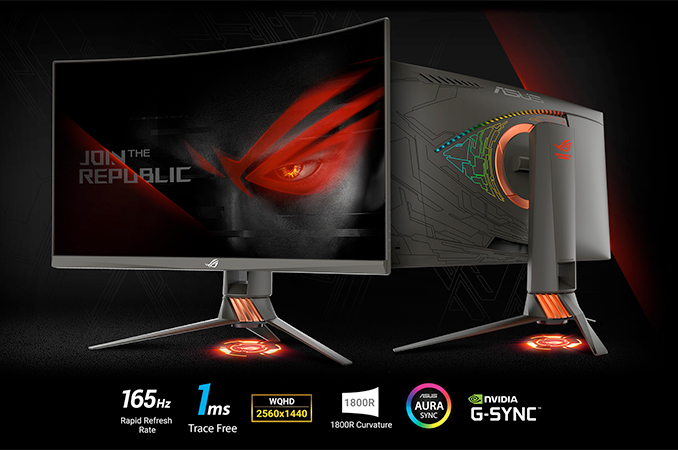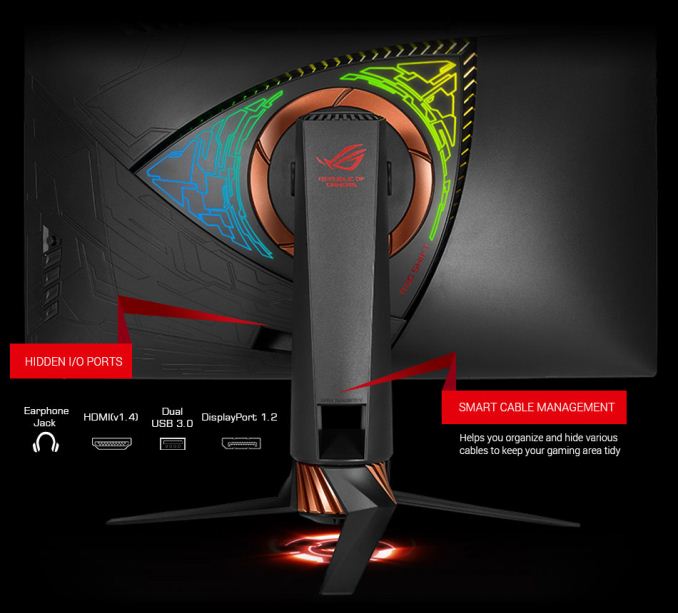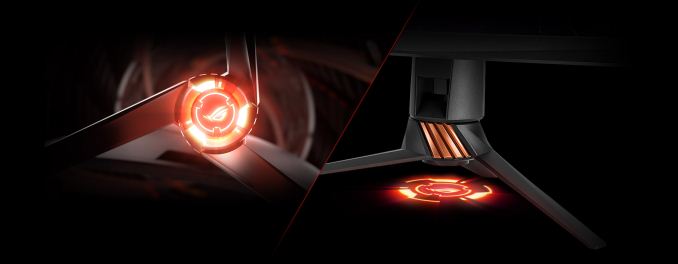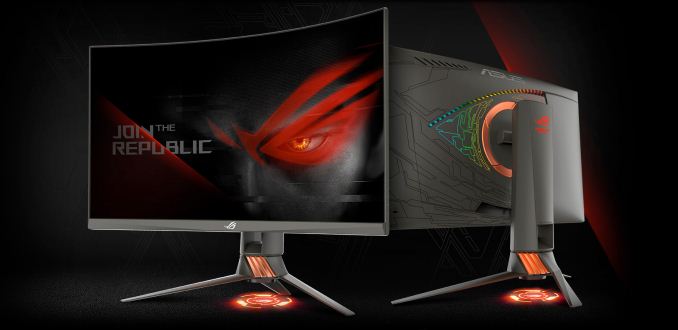ASUS Launches ROG Swift PG27VQ: Curved 27-inch LCD with 165 Hz G-Sync & RGB Lighting
by Anton Shilov on November 18, 2017 10:00 AM EST
ASUS is about to start selling its new ROG Swift PG27VQ, the company's latest 165Hz monitor. Aimed at gamers who are looking for a very high responsiveness in games along with ultimate style, the monitor features a curved panel and 1 ms response time. To make design of the ROG Swift PG27VQ unique, ASUS added its RGB Aura Sync lighting to the back of the display.
RGB LED lighting has (inexplicably) become a signature feature of gaming hardware in 2017. As we've already seen, there are motherboards, graphics cards, memory modules, chassis, PSUs, keyboards, mice, even SSDs with RGB LEDs, on the market these days. Earlier this year ASUS decided to complete the list of RGB lighting-enabled devices with its curved ROG monitors. So far, the company formally introduced three of such displays, but only the relatively inexpensive ROG Strix XG27VQ has been released commercially so far. ASUS is going to change this in the coming weeks as it is getting ready to start sales of the considerably more expensive ROG Swift PG27VQ.
The ASUS PG27VQ uses a 27” TN panel with a 2560×1440 resolution, an “overclockable” 165 Hz refresh rate, a 1 ms response time as well as a 1800R curvature. Responsiveness is a major selling point of the monitor, which is a reason why the manufacturer went with a TN panel featuring 400 nits brightness, 1000:1 contrast ratio and 170°/160° viewing angles, nothing unexpected from TN here. As for ergonomics, the ROG Swift PG27VQ can adjust height, tilt, swivel or can be attached to a VESA wall mounting. Those interested in a multi-display configuration will be glad to know that the display has thin bezels. As for connectivity, the monitor comes with an HDMI 1.4, a DisplayPort 1.2, a dual-port USB 3.0 hub and an earphone jack.
Just like any other ‘Republic of Gamers’ monitor from ASUS, the ROG Swift PG27VQ features a host of features aimed just at gamers. Firstly, it supports NVIDIA’s G-Sync dynamic refresh rate technology with ULMB, which is designed to make fast-paced actions look sharper. The combination of a 165 Hz maximum refresh rate, 1 ms response time as well as G-Sync with ULMB should deliver rather impressive experience. Secondly, the monitor comes with the ASUS Aura Sync RGB lighting on the back to customize the look of the display or even synchronize its lighting with other components featuring the technology. In addition, the LCD has ROG’s LED lighting projection signature on the bottom, which owners can customize as well. Thirdly, the monitor supports the ASUS GamePlus modes, which are present on other gaming monitors by the company, and ASUS GameVisual color profiles for different type of content. Finally, the monitor is compatible with NVIDIA’s 3D Vision technology for those who still have the shutter 3D glasses kit (or plan to get one now).
| ASUS 'Most Responsive' 27" Curved Gaming Monitor | ||
| ROG Swift PG27VQ | ||
| Panel | 27" TN | |
| Native Resolution | 2560 × 1440 | |
| Refresh Rate Range | 165 Hz overclockable | |
| Dynamic Refresh Rate | G-Sync with ULMB | |
| G-Sync Range | unknown | |
| Response Time | 1 ms (gray-to-gray) | |
| Brightness | 400 cd/m² | |
| Contrast | 1000:1 | |
| Viewing Angles | 170°/160° | |
| Curvature | 1800R | |
| Inputs | HDMI 1.4 DisplayPort 1.2 |
|
| Audio | 3.5 mm audio jack | |
| USB Hub | Dual-port USB 3.0 hub | |
| RGB Effects | ASUS Aura Sync RGB lighting | |
| Proprietary Enhancements | Trace Free Technology Color Temperature Selection: 4 Modes GamePlus Modes: Crosshair/Timer/Display Alignment Low Blue Light: Yes GameVisual Modes: Scenery/Racing/Cinema/RTS/RPG/FPS/sRGB |
|
| Power Consumption |
Idle | 0.5 W |
| Active | 67.5 W | |
| Detailed Information | Link | |
The ASUS ROG Swift PG27VQ is expected to be available from leading retailers like Amazon and Newegg in several weeks. Being a unique offering, the new unit will cost $799.99, a price tag well above average for a 27” monitor.
- ASUS ROG Strix XG27VQ Available: 27” Curved, FHD@144Hz & FreeSync w/ELMB
- ASUS Announces Designo Curve MX38VQ: 37.5 Inch Curved Display with Qi Charging
- ASUS Starts to Ship Its First Curved Ultra-Wide Display: ROG Swift PG348Q
- Acer Predator Z35P Available for Order: Curved 35" with 3440×1440@120 Hz and G-Sync
- AOC Expands AGON Family with Curved AG322QCX and AG272FCX 144 Hz Displays
- AOC’s Entry-Level C2789FH8 27” Display Weds Gold, Bling, and Curvature
Source: ASUS



















46 Comments
View All Comments
qap - Monday, November 20, 2017 - link
Refresh rate is not the same thing as response time. Competitive gamers require both, so AH-IPS is not a solution for everyone. 165Hz AH-IPS is still inferior in response time to TN panel (it will be around 30ms).So no - this panel is no "joke". It is just for a very specific users.
TheWereCat - Monday, November 20, 2017 - link
Check Tomshardware review of ASUS PG279Q (AH-IPS) vs ASUS PG278Q (TN).The measured response time between them makes the TN one only 1ms better which makes no difference.
It is 7ms vs 8ms in Full Black to White response time.
And also 1ms difference in absolute input lag... 24ms vs 25ms.
BurntMyBacon - Monday, November 20, 2017 - link
@qap: "165Hz AH-IPS is still inferior in response time to TN panel (it will be around 30ms)."Inferior? Yes, ... , to a small extent.
30ms? You need to reassess the situation.
Given that this article is about a new Asus ROG monitor, I'm going to use two models in the same series as a comparison. I'll be using tftcentral as a source:
http://www.tftcentral.co.uk/reviews/asus_rog_swift...
Asus ROG Swift PG278Q response time: 2.9ms avg/4.4ms max
Asus ROG Swift PG279Q response time: 5.0ms avg/6.5ms max
So AH-IPS is 2.1ms slower to respond than TN in the most equivalent comparison. Of course the article points out that the TN panel had more overshoot to get the faster response. If the AH-IPS was driven to the same overshoot, the difference would be even less. This comparison is very relevant as the monitor in this article is from the same manufacturer, the same series, and uses a panel very similar in specification to the PG278Q only with a curve.
Putting this all in perspective, the 5ms (avg) response time of the AH-IPS is less than 1 frame given its 165hz refresh rate. The 6.5ms (max) response time is still less than a frame on a 144hz panel. You'll still have to decide whether you want a slightly slower, but cleaner response (less overshoot) and all the other advantages that AH-IPS brings or whether the extra speed (and better black level IIRC) is more meaningful to you.
Side note: You might also be interested to know that the PG279Q requires less signal processing (due to its AH-IPS panel) and has both lower signal processing lag and overall display lag (3.25ms) vs the PG278Q (4ms):
http://www.tftcentral.co.uk/reviews/asus_rog_swift...
StrangerGuy - Monday, November 20, 2017 - link
Shhhh stop with the facts, you are turning the TN defenders into buyer remorse mode.Then again, if one still buys that "TN = gaming, IPS = bad in gaming because TN 1ms GTG" in 2017 then they deserve to get ripped off for lack of basic Googling skills.
Opencg - Monday, November 20, 2017 - link
Actaully if you want the facts at 165hz a frame is 6.06ms. So a 2.9ms transition would have 52% of the frame as the right color while the IPS at 5ms would have only 17% of the frame at the right color. Its easy to see why IPS wins in ANY case where reaction time is important.Opencg - Monday, November 20, 2017 - link
Lol compareing 2.9ms to 5ms. For competitive gaming that TN would smoke the IPSAlistair - Sunday, November 19, 2017 - link
This is a seriously stupid monitor. Basically they wanted to increase the price on their old crap g-sync TN panel...StevoLincolnite - Monday, November 20, 2017 - link
TN.Curved.
RGB.
27"
Just a bunch of NOPE NOPE NOPE. Even if it is 165hz.
Dug - Saturday, November 18, 2017 - link
Is it April Fools?$800 for that ugly thing?
No thanks.
Space Jam - Saturday, November 18, 2017 - link
Does ULMB support >100Hz yet?